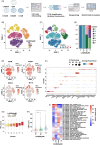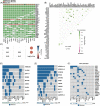Single-cell profiling-guided combination therapy of c-Fos and histone deacetylase inhibitors in diffuse large B-cell lymphoma
- PMID: 35522945
- PMCID: PMC9076017
- DOI: 10.1002/ctm2.798
Single-cell profiling-guided combination therapy of c-Fos and histone deacetylase inhibitors in diffuse large B-cell lymphoma
Abstract
Background: Diffuse large B-cell lymphoma (DLBCL) is the most common subtype of non-Hodgkin lymphoma. Histone deacetylase inhibitors (HDACis) have been widely applied in multiple tumours, but the expected efficacy was not observed in DLBCL. Therefore, this study is aimed to explore superior HDACis and optimise a relative combinational therapeutic strategy.
Methods: The antitumour effects of the drug were evaluated by Cell Counting Kit-8 (CCK-8) assay and apoptosis analysis. Single-cell RNA sequencing (scRNA-Seq) was used to analyse the intratumoural heterogeneity of DLBCL cells. Whole-exome sequencing and RNA sequencing were performed to analyse the genetic and transcriptional features. Western blotting, qRT-PCR, protein array, immunohistochemistry, and chromatin immunoprecipitation assays were applied to explore the involved pathways. The antitumour effects of the compounds were assessed using subcutaneous xenograft tumour models.
Results: LAQ824 was screened and confirmed to kill DLBCL cells effectively. Using scRNA-Seq, we characterised the heterogeneity of DLBCL cells under different drug pressures, and c-Fos was identified as a critical factor in the survival of residual tumour cells. Moreover, we demonstrated that combinatorial treatment with LAQ824 and a c-Fos inhibitor more potently inhibited tumour cells both in vitro and in vivo.
Conclusion: Altogether, we found an HDACi, LAQ824, with high efficacy in DLBCL and provided a promising HDACi-based combination therapy strategy.
Keywords: combination treatment; diffuse large B-cell lymphoma; histone deacetylase inhibitor; single-cell RNA sequencing.
© 2022 The Authors. Clinical and Translational Medicine published by John Wiley & Sons Australia, Ltd on behalf of Shanghai Institute of Clinical Bioinformatics.
Conflict of interest statement
The authors declare that they have no conflict of interest.
Figures







Comment in
-
Single-cell profiling guided combination therapy of c-Fos and histone deacetylase inhibitors in diffuse large B-cell lymphoma.Clin Transl Med. 2022 May;12(5):e858. doi: 10.1002/ctm2.858. Clin Transl Med. 2022. PMID: 35604882 Free PMC article.
Similar articles
-
A model of sensitivity and resistance to histone deacetylase inhibitors in diffuse large B cell lymphoma: Role of cyclin-dependent kinase inhibitors.Cancer Biol Ther. 2013 Oct 1;14(10):949-61. doi: 10.4161/cbt.25941. Epub 2013 Aug 2. Cancer Biol Ther. 2013. PMID: 23982416 Free PMC article.
-
Study of the antilymphoma activity of pracinostat reveals different sensitivities of DLBCL cells to HDAC inhibitors.Blood Adv. 2021 May 25;5(10):2467-2480. doi: 10.1182/bloodadvances.2020003566. Blood Adv. 2021. PMID: 33999145 Free PMC article.
-
Single-cell profiling guided combination therapy of c-Fos and histone deacetylase inhibitors in diffuse large B-cell lymphoma.Clin Transl Med. 2022 May;12(5):e858. doi: 10.1002/ctm2.858. Clin Transl Med. 2022. PMID: 35604882 Free PMC article.
-
Non-Hodgkin's lymphoma: the old and the new.Clin Lymphoma Myeloma Leuk. 2011 Jun;11 Suppl 1:S87-90. doi: 10.1016/j.clml.2011.03.029. Epub 2011 Apr 28. Clin Lymphoma Myeloma Leuk. 2011. PMID: 22035756 Review.
-
Emerging role of histone deacetylase inhibitors in the treatment of diffuse large B-cell lymphoma.Leuk Lymphoma. 2020 Apr;61(4):763-775. doi: 10.1080/10428194.2019.1691194. Epub 2019 Nov 26. Leuk Lymphoma. 2020. PMID: 31766900 Review.
Cited by
-
Defining the heterogeneous molecular landscape of lung cancer cell responses to epigenetic inhibition.bioRxiv [Preprint]. 2024 Sep 24:2024.05.23.592075. doi: 10.1101/2024.05.23.592075. bioRxiv. 2024. PMID: 38853901 Free PMC article. Preprint.
-
Single-cell sequencing analysis of multiple myeloma heterogeneity and identification of new theranostic targets.Cell Death Dis. 2024 Sep 14;15(9):672. doi: 10.1038/s41419-024-07027-4. Cell Death Dis. 2024. PMID: 39271659 Free PMC article.
-
Advances in single-cell RNA sequencing and its applications in cancer research.J Hematol Oncol. 2023 Aug 24;16(1):98. doi: 10.1186/s13045-023-01494-6. J Hematol Oncol. 2023. PMID: 37612741 Free PMC article. Review.
-
m6A-Modified circTET2 Interacting with HNRNPC Regulates Fatty Acid Oxidation to Promote the Proliferation of Chronic Lymphocytic Leukemia.Adv Sci (Weinh). 2023 Dec;10(34):e2304895. doi: 10.1002/advs.202304895. Epub 2023 Oct 11. Adv Sci (Weinh). 2023. PMID: 37821382 Free PMC article.
-
Rupatadine-inhibited OTUD3 promotes DLBCL progression and immune evasion through deubiquitinating MYL12A and PD-L1.Cell Death Dis. 2024 Aug 3;15(8):561. doi: 10.1038/s41419-024-06941-x. Cell Death Dis. 2024. PMID: 39097608 Free PMC article.
References
-
- McNally DR, Elemento O, Melnick A. Dissecting bulk transcriptomes of diffuse large B cell lymphoma. Cancer Cell. 2021;39(10):1305‐1307. - PubMed
-
- Romanski A, Bacic B, Bug G, et al. Use of a novel histone deacetylase inhibitor to induce apoptosis in cell lines of acute lymphoblastic leukemia. Haematologica. 2004;89(4):419‐426. - PubMed
-
- Kim MS, Kwon HJ, Lee YM, et al. Histone deacetylases induce angiogenesis by negative regulation of tumor suppressor genes. Nat Med. 2001;7(4):437‐443. - PubMed
Publication types
MeSH terms
Substances
LinkOut - more resources
Full Text Sources
